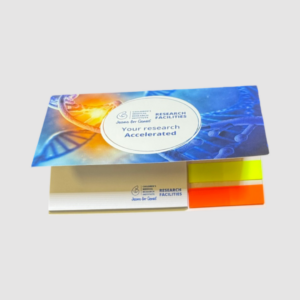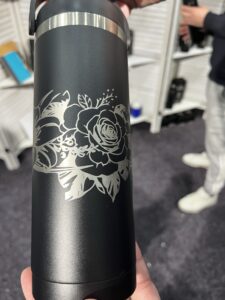What is Offset Printing?
Offset printing is a branding method that allows printing large quantities of paper print items with sharp, professional-quality results. Instead of applying ink directly to paper like a regular printer, offset printing first transfers the image onto a metal plate. The plate then presses the ink onto a rubber roller, finally printing the image onto paper. This process ensures consistent colours, crisp details, and high-quality prints every time. Because it’s cost-effective and efficient for bulk printing, businesses and publishers choose offset printing when they need large runs of premium printed materials.
How Offset Printing is Applied
The offset printing process involves the following:
- Creating the Metal Printing Plates: Each colour in the design (typically Cyan, Magenta, Yellow, and Black – CMYK) requires a separate metal plate. These plates are laser-etched with the design and loaded onto the printing press.
- Transferring the Inked Design: We will first transfer the inked design instead of printing directly on the surface to ensure the ink is evenly distributed and to prevent wear on the metal plates.
- Applying Ink to the Paper: The rubber blanket rolls over the paper, transferring the image with sharp detail and vibrant colours.
- Drying & Finishing: The paper passes through drying units to prevent smudging once printed. After drying, it can be gloss-coated, laminated, or cut to size for the final product.
Advantages of Offset Printing
Offset printing is one of the most efficient and high-quality methods available, making it a top choice for bulk print orders. Clients choose this method because:
- Superior Print Quality: Produces sharp, crisp images and fine details.
- Consistent Colours & Gradients: It uses CMY colour separation to ensure accurate and uniform colour reproduction across all printed materials.
- Wide Range of Paper & Finishing Options: Works on various paper types and thicknesses, including glossy, matte, UV coatings, or embossing for a high-end look.
- Ideal for Large Format & High-Resolution Prints: Capable of printing large posters, banners, and marketing materials with photographic quality.
Disadvantages of Offset Branding Technique
While this method is a technique adopted by the print industry, there are some factors we would like you to consider:
- Not Cost-Effective for Small Orders: Offset printing requires plate setup and machine calibration, so it is not ideal for short print runs (less than 500 copies).
- Longer Turnaround Time: The setup, plate-making, and drying process mean offset printing takes longer than digital printing.
- Limited to CMYK & Spot Colours: While it provides excellent colour accuracy, offset printing does not support RGB, highly metallic finishes, or other methods like foil printing.
Best Surfaces for Offset Printing
Offset printing is designed for smooth, absorbent surfaces that allow Ink to transfer cleanly without distortion. The ideal surfaces for this technique are:
- Glossy & Matte Paper Stocks: Commonly used for brochures, flyers, magazines, and catalogues.
- Cardstock & Thick Paper: Used for business cards, postcards, and presentation folders, offering durability and a premium feel.
- Newsprint & Uncoated Paper: Best for bulk newspaper printing, booklets, and office documents.
- Recycled and Synthetic Paper: The offset printing technique also works on recycled paper and other environmentally sourced paper.
- Large Format Paper Rolls: Used for posters, banners, and signage, ensuring high-quality graphics at a large scale.
Examples of Promotional Items Using Offset Printing
Offset printing is ideal for marketing, corporate branding, and mass-distributed promotional materials. We apply them to items like:
- Custom Printed Sticky Notes
- Brochures
- Magazines & Catalogues
- Business Cards & Presentation Folders
- Posters & Large Format Prints
- Custom Packaging & Branded Paper Bags







